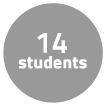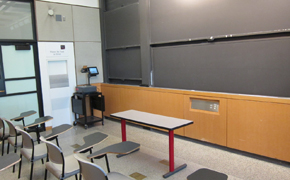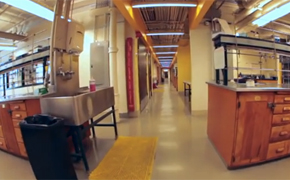Instructor Insights pages are part of the OCW Educator initiative, which seeks to enhance the value of OCW for educators.
Course Overview
This page focuses on the course 5.301 Chemistry Laboratory Techniques as it was taught by Dr. John Dolhun in January 2012.
Chemistry Laboratory Techniques is a "boot camp" course offering motivated first year MIT students intensive practical training in fundamental chemistry lab techniques within a condensed intra-semester session. It is intended to equip students who pass this rigorous course with the skills necessary to undertake original research projects in Chemistry. The class has limited enrollment and is only open to first year students. It prepares students for UROP ![]() positions by providing them with state of the art lab experiences and the opportunity to master essential techniques and skills.
positions by providing them with state of the art lab experiences and the opportunity to master essential techniques and skills.
Course Outcomes
Course Goals for Students
Students receive practical training in nearly all of the basic laboratory techniques. The goal of the course is to provide first year MIT students with the organizational and practical laboratory skills necessary to undertake original research projects in Chemistry.
Because freshman are not eligible to enroll in regular Chemistry lab courses, this course has been designed to give motivated first year students an opportunity to gain hands-on experience in a lab. The course also focuses on developing students' scientific writing and oral presentation skills.
Through a series of lab experiments, students sharpen their critical thinking, scientific and logical reasoning, and oral and written communication skills. Some of the techniques mastered in this course include transfer and manipulation of small quantities of chemical compounds and purification methods for liquid and solid substances including distillation, recrystallization, and column chromatography. Another component of the course is structure determination, which includes theory and operation of an NMR, infrared, UV, and mass spectrometer.
Students are routinely required to run instruments and interpret data to substantiate products obtained from their experiments. They maintain lab notes, provide an oral report on a topic related to their experimental results, and write a formal lab report on original research. At the completion of 5.301, students feel comfortable in the research lab and may secure a guaranteed UROP in their spring term in Chemistry.
Possibilities for Further Study and Future Careers
Students pursue UROPs in the Chemistry Department and in other departments.
I teach the course in a way that shows students I am excited about what I am teaching. The students need to be constantly engaged.
—John Dolhun
Below, Dr. John Dolhun describes various aspects of teaching 5.301 Chemistry Laboratory Techniques.
Preparing for the Course
- Instructors begin preparing for this rigorous and condensed course six weeks before students enter the lab. During this preparation period, teaching assistants engage in their own boot camp, completing all of the experiments students will complete--but in half the time.
- Safety is a key component of any lab-based course. We bring in two safety officers from the MIT Environment Health & Safety Office to address students on the first day of class before they ever step foot in the lab. One officer covers basic laboratory safety and the other discusses biological lab safety protocols.
Teaching Beginner Chemists
- One of the challenges I face in teaching this course is the fact that most of the students have had little to no Organic Chemistry before enrolling in the class. Initially, I need to fully draw out structures, while gradually teaching the students about bonding and nomenclature. By the end of the course I am able to use the most condensed structures. I also integrate a number of live chemical demonstrations into my lectures, which illustrate key concepts and keep students interested during the lectures. I teach the course in a way that shows students I am excited about what I am teaching. The students need to be constantly engaged.
Reinforcing Course Concepts Inside and Outside the Lab
- A key feature of this course is that is provides students with an opportunity to immediately implement in the lab what they learn in the lecture. Students routinely practice course disciplines after basic instruction, linking theory and practice.
- We ask students to visualize their experiments prior to coming to the lab. They write pre-lab notes in a laboratory notebook. The notes must be detailed enough so that another researcher could carry out the experiment using their notes. During the actual experiment students carry their notebooks, using them to record all of their observations and calculations as post-lab notes. All of the pages in students' notebooks are checked and initialed by the teaching assistants at both the start and end of the lab experiment. Students submit the signed pages to the teaching assistants at the close of lab daily. Students learn early on how important a research quality lab notebook is.
- Oral reports are another important element of Chemistry Laboratory Techniques. Each student presents a 10 minute oral report on an assigned topic related to their results from one of the experiments in the course. Many freshmen have never given an oral presentation before. The procedure builds their confidence. At the end of the report, they are questioned by other students, the teaching assistants, and the instructor. This aspect of the course is designed to prepare students who take on UROPs to participate productively in research group meetings.
- Every student must submit a final formal lab report on the experimental results from his or her original research. The written formal lab report must include all of the traditional components that one finds in a research quality paper. Learning how to write a formal lab report is important and helps students who go on to publish UROP research.
- Learing how to maintain a research laboratory notebook, how to deliver an oral report, and how to write a formal laboratory report are important skills that students maintain when they leave the course irrespective of what field of study they decide to enter.
Curriculum Information
Prerequisites
Requirements Satisfied
- UROP qualification for freshmen
Offered
- Offered each IAP
 since 2009
since 2009

Breakdown by Year
All freshmen
Breakdown by Major
Undeclared
Typical Student Breakdown
Most students who enroll in this intensive course have had basic or AP high school Chemistry; however, some of their AP classes may not have had lab components. Other students have had basic labs such as titrations. Additionally, students often come with lab experiences in other fields such as Psychology, Biology and Physics. Typically they take courses at MIT such as: 5.111, 5.112, 8.01, 8.012, 8.03, and 18.02.
Many students have had little Chemistry lab experience at MIT, but have been exposed to the theoretical side of the subject matter. They like Chemistry, or are interested in it, but are still unsure about what their major will be. They are interested in learning new lab techniques, learning how to work in a research lab and how to correctly present their research results.
Enrollment Cap and Reason for Enrollment Cap
Enrollment is capped at 14. Students completing 5.301 are guaranteed a UROP with a Chemistry faculty member. The limited number of guaranteed UROP positions dictates the enrollment cap in 5.301.
Ideal Class Size and Reason
The ideal class size is 12-14 students. This number of students allows instructors to provide freshmen, who come with limited lab experience, with the supervision and support they need to succeed in the course. This class size also enables instructors to maintain rigorous safety standards in the lab. A class of 12-14 students is ideal for holding productive group meetings and for allowing students to deliver oral reports. The limited number of UROP positions is also a consideration in keeping this class small.
During an average week, students were expected to spend 35 hours on the course, roughly divided as follows:
Lecture
- Mandatory morning lecture and group discussion
- 13 lecture sessions total
- One hour of the lecture session is spent covering the principle behind that day’s lab work, demonstrating the equipment and techniques, and answering questions
- Formal lecture time is followed by a one-hour break during which students work in groups to discuss potential issues related to the day's experiment
Laboratory
- Mandatory afternoon lab work
- 13 sessions and one full day session of original research
- TAs give a 30-minute pre-lab lecture reviewing safety protocols and some techniques
- Students perform daily experimental work for 4-5 hours per session, during which they master essential chemistry techniques and complete original research
Semester Breakdown
| WEEK | M | T | W | Th | F |
|---|---|---|---|---|---|
| 1 |  |  |  |  |  |
| 2 |  |  |  |  |  |
| 3 |  |  |  |  |  |
| 4 |  |  |  |  |  |
 No classes throughout MIT
No classes throughout MIT Morning lecture followed by afternoon lab
Morning lecture followed by afternoon lab No class to allow students to work on final reports
No class to allow students to work on final reports No class session scheduled
No class session scheduled Lab session without accompanying lecture
Lab session without accompanying lecture Final lab report due
Final lab report due

 Room 1 of 2
Room 1 of 2 
